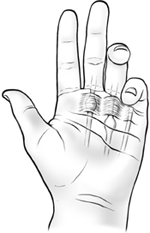Will My Finger Ever Be Able to Bend Again After Trigger Finger
Trigger Finger & Trigger Thumb
Trigger finger or trigger thumb is a condition that causes your fingers or thumb get stuck in a bent position. Those with trigger finger or trigger thumb may have stiffness when bending the finger(s) or hear snapping and popping when moving the finger(s). Depending on the severity of the condition, treatment options can range from rest to surgery.
Overview

What is trigger finger and trigger thumb?
Trigger finger or trigger thumb is when your fingers or thumb get stuck in a bent position – as if squeezing a "trigger." Trigger finger can occur in one or more fingers. The ring finger is often one of the fingers affected. The condition is also known as stenosing tenosynovitis.
Who gets trigger finger or trigger thumb?
Trigger finger or trigger thumb is more commonly seen in:
- People who have jobs, hobbies, or tasks that require strenuous repetitive motions; frequent, strong grasping or gripping, or forceful use of the fingers and/or thumb. For example, trigger finger frequently occurs in people who use their fingers or thumbs for multiple repetitive movements. These people may include:
- Farmers
- Industrial workers
- Musicians
- People who have osteoarthritis, rheumatoid arthritis, gout or diabetes.
- People between the ages of 40 and 60.
Symptoms and Causes
What causes the finger(s) or thumb to remain bent?
Tendons are bands of tissue that attach muscles to bones. In the hand, tendons and muscles must work together to flex and straighten your fingers and thumb. Usually, tendons slide easily through a tunnel of tissue called a sheath. The sheath keeps the tendons in place next to the bones of the finger(s) or thumb. With trigger finger or trigger thumb, the tendons become irritated and swollen (inflamed) and can no longer easily slide through their sheaths. A bump (nodule) may also form on the tendon, which makes it even more difficult for the tendon to easily glide through its sheath.
What are the signs and symptoms of trigger finger or trigger thumb?
Signs and symptoms of trigger finger or trigger thumb include:
- Snapping or popping sensation when moving the finger(s) or thumb.
- Soreness at the base of the finger or thumb in the palm, especially while gripping or grasping.
- Pain and stiffness when bending the finger(s) or thumb.
- Swelling or tender lump in the palm of the hand.
- Locking of the finger(s) or thumb in the bent position (in severe cases). The finger(s) or thumb must be gently straightened with the help of the other hand.
- Inability to fully flex the finger.
The stiffness and bent position of the finger(s) or thumb are worse in the morning. The stiffness lessens as the fingers and thumb are used.
Management and Treatment
How are trigger finger or trigger thumb treated?
For mild cases, the first step is to rest the finger(s) or thumb and limit or avoid the activities that are causing symptoms. Sometimes a splint may be used on the affected finger(s) to keep the joint from moving. If symptoms continue, anti-inflammatory medications, such as ibuprofen, may be prescribed or steroid injection(s) may be considered.
If the condition does not respond to non-surgical treatments or continues to recur, surgery may be recommended. The surgery is done under local anesthesia (you will be awake but may be sedated for comfort) and does not require a hospital stay.
During the surgery, a tiny cut is made in the sheath through which the tendons pass. Cutting the sheath widens the space around the tendons of the affected finger(s) or thumb. This allows the tendon to slide more easily through the sheath. The surgery helps restore the affected finger(s) or thumb's ability to bend and straighten without pain or stiffness.
Recovery time following surgery is typically only a couple of weeks. However, recovery times vary, depending on your age, general health, and how long the symptoms have been present.
stephensenwhaters.blogspot.com
Source: https://my.clevelandclinic.org/health/diseases/7080-trigger-finger--trigger-thumb
